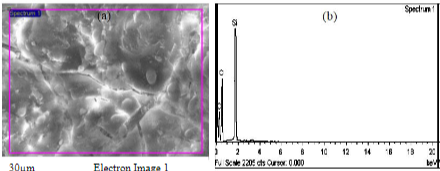Characterisation of oil palm trunk and frond as fuel for biomass thermochemical
Author: Shaharin Anwar Sulaiman - June 2020
Abstract
The rate of oil palm production in Malaysia increases annually and as a result, the oil palm wastes, especially oil palm trunk (OPT) and oil palm fronds (OPF) remain abundant. A suitable way of converting this abundant waste to renewable energy is through thermochemical conversion. Thus, this study investigates the characteristics of OPT and OPF biomass, for use as feedstock in thermochemical processes like gasification, pyrolysis, and combustion. The analysis carried out includes; ultimate (CHNSO) and proximate (thermogravimetric) analysis, calorific value, field emission scanning electron microscopy (FESEM) and x-ray fluorescence (XRF). Both feedstocks exhibited potential for use as fuel in biomass thermochemical conversion. The CHNSO analysis showed the presence of sufficient carbon, hydrogen and oxygen elements in both feedstocks, with carbon being the highest 45.42% in OPT and 43.35% in OPF. The percentages of nitrogen and sulphur which are required to be less for a good fuel were also obtained in low quantities for both fuel; 0.47% and 0.13% in OPT and 0.76% and 0.45% in OPF, respectively. The thermogravimetric analysis revealed both feedstocks to be having high volatile matter 62.28% in OPT and 66.10% in OPF. Meanwhile, sufficient fixed carbon content of 26.18% in OPT and 25.68% in OPF with low ash content of 9.82% in OPT and 6.32% in OPF were obtained in the analysis. FESEM and XRF were used to investigate the surface morphology, elemental and mineralogical nature of the samples. The findings were compared with those of other biomass and non-biomass materials. The EDX graph showed the presence of carbon and oxygen in a higher amount while in the XRF analysis CaO and K2O were the major oxides present in both OPT and OPF, with a low amount of SiO making the feedstocks less prone to agglomeration during thermochemical conversion
Methodology
The heating value of a material can be expressed in either lower (LHV) or higher heating value (HHV). The former is obtained when the heat of the combustion of the sample was determined relative to gaseous water while the latter is obtained when the product of the heat of combustion of the sample was determined relative to liquid water. The between the two values gives the latent heat of the product water. In the given study, the Leco AC-350 bomb calorimeter was used for the determination of heating values
Impact & Benefits
Utilization of Abundant Waste:By investigating the characteristics of OPT and OPF for thermochemical conversion, the study aims to provide a sustainable solution for converting these waste materials into renewable energy.
Feedstock Characteristics Analysis: arious analyses, including ultimate (CHNSO) and proximate (thermogravimetric) analysis, calorific value determination, field emission scanning electron microscopy (FESEM), and x-ray fluorescence (XRF) are conducted.
Surface Morphology and Elemental Analysis:FESEM and XRF analyses are employed to investigate the surface morphology, elemental composition, and mineralogical nature of the samples.
Prevention of Agglomeration: The low SiO content suggests that OPT and OPF are less prone to agglomeration during thermochemical conversion, contributing to the efficiency and longevity of the conversion processes.
Market Potential
Annual Increase in Oil Palm Production: The study acknowledges the annual increase in oil palm production in Malaysia, leading to a significant accumulation of oil palm wastes, particularly OPT and OPF.
Thermochemical Conversion for Renewable Energy: The investigation aims to explore the conversion of abundant oil palm waste into renewable energy through thermochemical processes.
Analytical Methods: Various analyses were conducted, including ultimate analysis (CHNSO), proximate analysis (thermogravimetric), calorific value determination, field emission scanning electron microscopy (FESEM), and x-ray fluorescence (XRF).
Thermogravimetric Analysis: Thermogravimetric analysis indicates high volatile matter content (62.28% in OPT and 66.10% in OPF) and sufficient fixed carbon content (26.18% in OPT and 25.68% in OPF).


